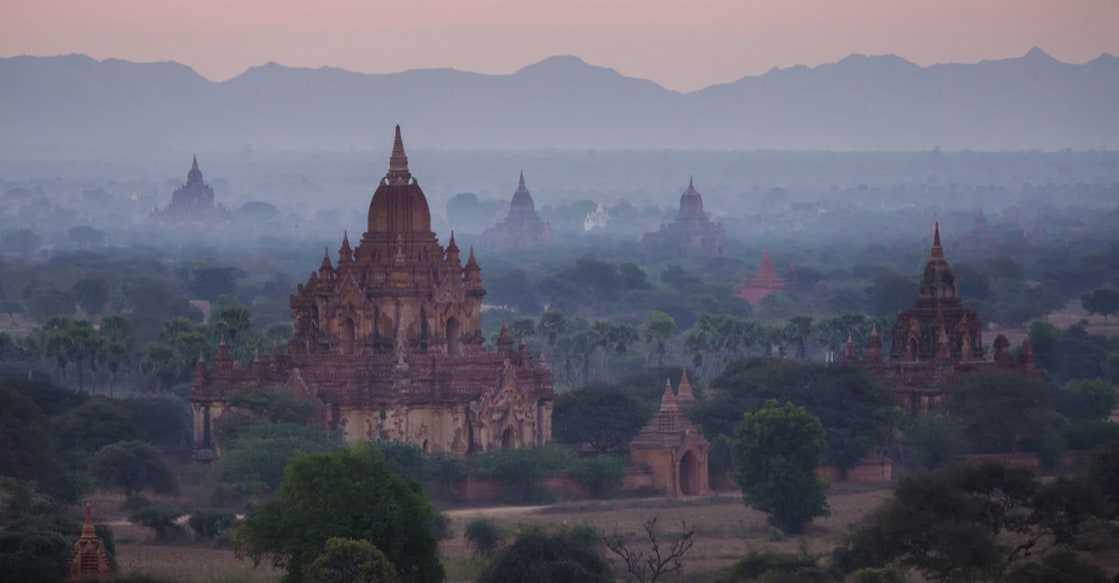Column | A Kerala merchant and Bagan’s ancient Vishnu temple

Mail This Article
With its thousands of pagodas, temples and monasteries that were built between the 9th and 13th centuries, the ancient city of Bagan (formerly Pagan) in Myanmar is probably the greatest man-made wonder in Southeast Asia. It’s possible to spend several months on the Bagan plain and see just a fraction of its monuments.
Hidden among the 2,000 plus temples and pagodas that survive till this day in Bagan is the 11th century Nathlaung Kyaung Vishnu temple. This grand temple has a major connection with a merchant from Kodungallur.
“A certain Irayiran Siriyan alias Sri Kulasekhara Nambi of Makotayarpattanam in Malaimandalam constructed a Vishnu temple in Pagan (Burma) and left a record in mixed Tamil and Grantha script there,” acclaimed historian M G S Narayanan wrote in his book Perumals of Kerala. “The Tamil record is prefaced by a beautiful Sanskrit sloka from the Mukundamala of Kulasekhara Alvar.”
The Sanskrit sloka from the Mukundamala, inscribed on sandstone reads: “Let there be prosperity. (I have) no regard for merit, none for a heap of wealth, none at all for the enjoyment of lust. Whatever is to happen, O God! (will happen) in accordance with previous actions. This (alone) is to be prayed for (and) highly valued by me. In every other birth also let (me) possess unswerving devotion to the pair of thy lotus-feet!”
Siriyan was among a few Kerala merchants of the 11th century who went to Southeast Asia, according to Narayanan, who has headed the history department at the University of Calicut. The book, which was his 1972 doctoral thesis, also talks of migration of Malayalis to the island of Sumatra, now a part of Indonesia.
Expedition by a German Indologist

Much of what the world knows about the Vishnu temple in Bagan is on account of the writings of Eugen Julius Theodor Hultzsch, an Indologist and epigraphist, who is best known for deciphering the inscriptions of Emperor Ashoka. Hultzsch, who worked as an epigraphist for the Archaeological Survey of India, visited Bagan in the 19th century, where he came across the Vishnu temple.
Hultzsch wrote about the Vishnu temple in his book Epigraphia Indica, which was published in 1903. The German was the first to decipher what was inscribed on the sandstone in Sanskrit and Tamil. The stone is no longer in the temple complex but is on display at the National Museum in Bagan.
The German Indologist believed that the temple might have been constructed before Siriyan came to Bagan. The Tamil inscription from Siriyan reads: “I, Irayiran Siriyan alias Kulasekhara Nampi, of Makotayar Pattanam in Malaimantalam, erected the front hall in the temple, called Nanatechi Vinnakar at Pukkam alias Arivattanapuram, fixed the gate and gifted a lamp to burn in this hall continuously. This charity is to be known as Malaimantalattan.”
Locals in Bagan refer to Siriyan as a Vaishnavite saint from the Malabar, who built the mandapa in the 13th century, but this belief is based on the writings of Hultzsch. Historian Narayanan argued in his thesis that the Malayali merchant was probably in Bagan in the 11th century. “The Government of India Epigraphist (Hultzsch) has placed this undated record in the 13th century on palaeographical grounds but it is more likely that the quotation from Kulasekhara of the Chera period indicates the period of the Chera kings of Makotai, when the Vaishnavite cult gained ascendancy in Kerala,” he wrote. The Perumals of Makotai dynasty lasted from the 9th to 12th century.
Regardless of whether Irayiran Siriyan built the original temple or just the extension and the mandapa, he left an indelible mark in Burma.
Immigrants from southern India as well as Brahmin priests that served the Buddhist Burmese royalty prayed at the Vishnu temple in Bagan, before the Pagan Empire collapsed at the end of the 13th century. Although it was not a site of pilgrimage for Burmese Buddhists, the temple was preserved well until the 19th century. Unfortunately, its main idol was stolen in 1890 by a German looter, who managed to smuggle it to Germany. It is now housed in a museum in Berlin.
The temple suffered damage during the devastating 1975 earthquake in Bagan, but statues of seven of Vishnu’s incarnations survive, as well as brick and stucco reliefs of Vishnu. The temple (and Bagan as a whole) is a testament to the flow and exchange of people, culture and ideas that existed between Ancient India and the land once known as Suvarnabhumi for millennia.
(Ajay Kamalakaran is the author of ‘A Week in the Life of Svitlana’ and ‘Globetrotting for Love and Other Stories from Sakhalin Island')


